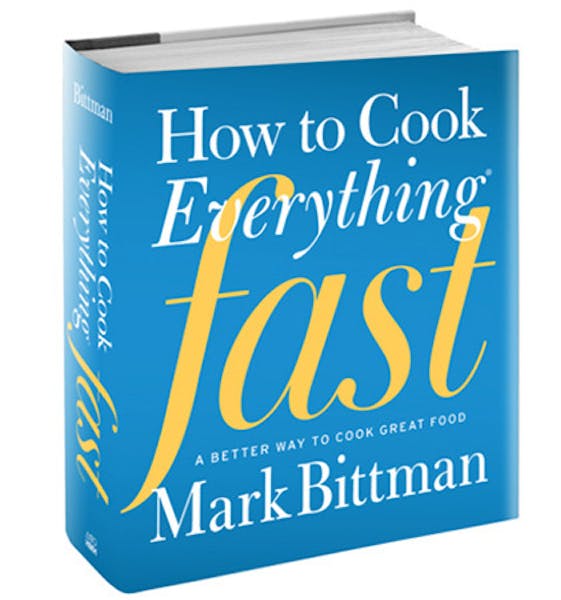Slaves to the recipe, listen up.
If you think everything has to be perfect, that instructions must be followed to a T, that any deviation might result in total tasteless disaster, a more easygoing approach could do you good. I found one in Mark Bittman's "How to Cook Everything Fast."
The New York Times food columnist and author of several doorstops full of recipes in the "How to Cook Everything" series has made ease one of his signature ingredients. In his new book, he's taken that approach a step further by rewriting the recipe for people who use recipes as a crutch.
Here, ingredients are listed whole. The recipes don't call for the garlic to already be minced, the kale to already be trimmed and chopped. Those steps, instead, are integrated into the directions. Bittman intersperses prep steps (in blue text) with cooking steps (in black text) for ultimate efficiency.
With this system, you avoid having to lay out all your ingredients on the counter and do all the chopping before you get started, only to end up at the frying pan waiting for one thing to finish before you can move on to the next. Mise en place, prepping everything ahead of time, says Bittman, is a myth.
Instead, Bittman gives you permission to do it all a little imperfectly. Heat the oil while you chop the onion. Cook the onion while you chop the celery. Dice the bell pepper while the previous vegetables cook, and add that. Gradually, you've got a holy trinity of vegetables, the makings of jambalaya, without it mattering that the onions were in the pan a little longer.
Bittman has written in his columns that he wants to help people "wean [themselves] from the recipe, or at least take better control of it." To accomplish that, he peppers the book with helpful master recipes for dishes like soup and stir fry, which could utilize whatever ingredients are on hand in your cabinets.
If recipe detail is something you live by, "How to Cook Everything Fast" might shake up your world. Bittman doesn't always say how long to cook things, or at what temperature. And he might tell you to slice leeks, for instance, but not how large or small, halved or whole rings. It can be confusing, but in a way, it gets you cooking more like a chef by asking you to consider how things smell and taste and feel.
The system works. Shrimp jambalaya, for which I tossed in the vegetables one at a time, came out perfectly creamy (and the veggies uniformly cooked) in just 40 minutes start to finish. Compared with a shrimp perloo from Cook's Country that required me to peel the shrimp and use the shells to make a stock before even getting to the vegetables and rice, Bittman's dish was a breeze and didn't lack for complexity.
Bittman gives you permission to experiment further at the end of each recipe, offering three categories to help cooks customize their dinners. First, a list of alternative ingredients that can transform a dish from French to Asian to Italian and beyond. Second, a preparation change that can make the cooking time go even faster — for instance, swapping turkey breast for thighs to speed up a braise. And finally, an index of side dishes.
If you have the time, Bittman gives you options to take longer on some dishes. Make your chicken stock from scratch, or soak dried beans instead of using canned. But most meals can be accomplished on a weeknight without much labor.
One night I made an entree of sea bass poached in a killer tomato-cream broth, along with a side of couscous and leek gratin, and the whole restaurant-quality meal took just over an hour. A dinner party for five, including two entrees, a side and a salad took about an hour and a half. We spent just 10 more minutes making dessert — luscious individual molten chocolate cakes.
The treasures here are the project dishes — meals like lasagna and roast turkey with stuffing — that home cooks wouldn't dream of assembling after a day at work. I had both on the table in under an hour thanks to Bittman's handy shortcuts: using fresh egg roll wrappers for lasagna noodles that don't require boiling; and butterflying the living daylights out of a turkey breast that roasts on a rimmed baking sheet, a moist sage and sausage stuffing pressed right on top.
Desserts could use more thought. While fresh fruit and cold milkshakes can satisfy a sweet tooth in a pinch, where are the quick takes on complicated baked goods? A couple of recipes for raw cookie dough (sans eggs) are innovative. Of the handful of baked goods in the book, those decadent molten lava cakes were an impressive dessert to whip up quickly.
The book also would be improved if Bittman provided menus in the same style as his recipes. I entertain, and would appreciate integrated cooking and prep steps for multiple dishes at one time. Imagine getting all of Thanksgiving dinner done in one easy flow, utilizing every free minute the turkey roasts for a perfectly choreographed kitchen dance, what Bittman calls "real-time cooking."
Also useful would be variations to make dishes gluten-free, vegetarian or vegan, or at the very least, an index pointing to those recipes.
Still, "How to Cook Everything Fast" is a handy cookbook for weeknight efficiency. By putting speed above perfection, it helps those of us who are slaves to recipes break the habit.
Sharyn Jackson • 612-673-4853
John Adams' Nativity oratorio 'El Nino' gets colorful staging at the Met
Taylor Swift's 'The Tortured Poets Department' is here. Is it poetry? This is what experts say
Finding an apartment may be easier for California pet owners under new legislation
4/20 grew from humble roots to marijuana's high holiday

